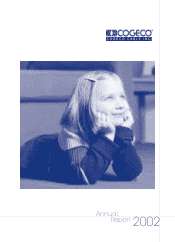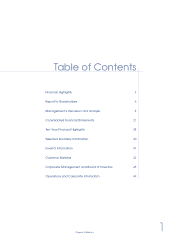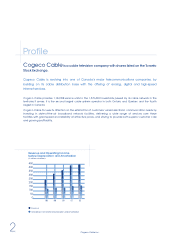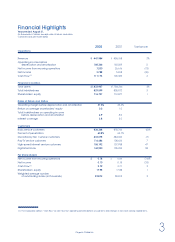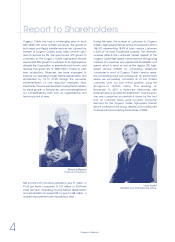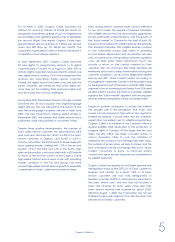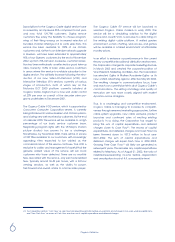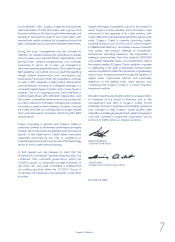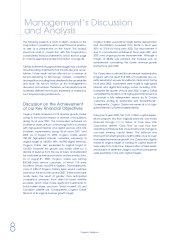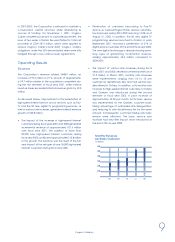Cogeco 2002 Annual Report Download - page 9
Download and view the complete annual report
Please find page 9 of the 2002 Cogeco annual report below. You can navigate through the pages in the report by either clicking on the pages listed below, or by using the keyword search tool below to find specific information within the annual report.
8Cogeco Cable Inc.
The following presents a more in-depth analysis of the
Corporation’s operations and current financial position,
as well as a perspective on the future. This analysis
should be read in conjunction with the Corporation’s
consolidated financial statements, which start on page
21 and the selected quarterly information on page 40.
Certain statements throughout these pages may constitute
forward-looking statements that involve risks and uncer-
tainties. Future results will be affected by a number o f
factors pertaining to technology, markets, competition
and regulation, including those described in the uncertainties
and main risk factors section of this management’s
discussion and analysis. Therefore, actual results may be
materially different from those expressed or implied by
such forward-looking statements.
Discussion on the Achievement
of our Key Financial Objectives
Cogeco Cable achieved a 2.1% revenue growth, mainly
owing to the full-year impact in revenue of acquisitions
during fiscal year 2001. The Corporation achieved an
increase in revenue from continued growth in customers
with high-speed Internet and digital services and rate
increases implemented during fiscal years 2001 and
2002. As of August 31, 2002, Cogeco Cable served
158,192 high-speed Internet customers, surpassing its
original target of 148,000. With 144,950 digital terminals,
Cogeco Cable also exceeded its original target of
130,000. However, this growth was mostly offset by a
decline in revenue from the loss of basic and extended
tier customers as well as promotions and price re d u c t i o n s .
As of August 31, 2002, Cogeco Cable was serving
836,368 basic service customers, of which 71% w e r e
located in Ontario and 29% in Quebec. This translates i n t o
a loss of 4.8% of Cogeco Cable’s basic service customer
base since the end of fiscal year 2001. These losses have
mostly been the result of greater than anticipated
competitive pre s s u res from direct-to-home satellite
providers, which have made significant investments to
build market share, and from “black market” US and
Canadian satellite use. Consequently, Cogeco Cable
fell short of its original revenue growth target.
Cogeco Cable’s operating margin before depreciation
and amortization increased from 36.6% in fiscal year
2001 to 37.6% for fiscal year 2002. This improvement is
due to cost reduction initiatives in fiscal years 2001 and
2002, and ongoing process improvements. Although a
margin of 38.5% was planned, the increase was an
a c h i e v e m e n t considering the slower revenue growth
during fiscal year 2002.
The Corporation continued its vast network modern i z a t i o n
p rogram with the result that 86% of households are cur-
rently served by two-way broadband cable plant. During
fiscal year 2002, investments were made in high-speed
I n t e rnet and digital technology niches, including VOD.
During the first quarter of fiscal year 2002, Cogeco Cable
completed the transition of its high-speed Internet service
to provide a fully independent service for its Ontario
customers, ending its relationship with Excite@HomeT M.
Consequently, Cogeco Cable now serves all of its high-
speed Internet customers independently.
During fiscal year 2002, the $122.1 million capital expen-
diture program, less than originally planned, was mostly
financed through $111.2 million of Cash Flow (the
Corporation defines “Cash Flow” as cash flow from
operating activities before unusual items and changes in
non-cash working capital items). The balance was
financed from existing bank credit facilities. Due to lower
than expected revenue growth, the Corporation slightly
missed its original target of funding its capital expendi-
tures solely from Cash Flow. Depreciation of fixed assets,
amortization of deferred charges, and financial expense
were essentially in line with original targets.
Management’s Discussion
and Analysis

